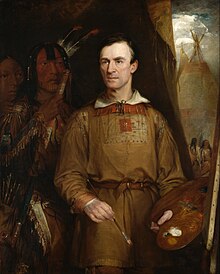George Catlin | |
|---|---|
 George Catlin by William Fisk, 1849 | |
| Born | July 26, 1796 |
| Died | December 23, 1872 (aged 76) Jersey City, New Jersey, U.S. |
| Alma mater | Litchfield Law School |
| Occupation(s) | Lawyer Painter Author |
| Spouse | Clara Bartlett Gregory |
| Signature | |
George Catlin (July 26, 1796 – December 23, 1872)[1] was an American lawyer, painter, author, and traveler, who specialized in portraits of Native Americans in the American frontier. Traveling to the American West five times during the 1830s, Catlin wrote about and painted portraits that depicted the life of the Plains Indians. His early work included engravings, drawn from nature, of sites along the route of the Erie Canal in New York State. Several of his renderings were published in one of the first printed books to use lithography, Cadwallader D. Colden's Memoir, Prepared at the Request of a Committee of the Common Council of the City of New York, and Presented to the Mayor of the City, at the Celebration of the Completion of the New York Canals, published in 1825, with early images of the City of Buffalo.[2][3]
- ^ "George Catlin". Encyclopædia Britannica. Retrieved June 29, 2020.
- ^ Laurence M. Hauptman; George Hamell (2003). "George Catlin: The Iroquois Origins of His Indian Portrait Gallery". In Alexander Clarence Flick (ed.). New York History: Quarterly Journal of the New York State Historical Association. Vol. 84. The Association. p. 125.
...nevertheless, the artist, who viewed himself as a visual historian documenting a "vanishing race," produced a wide array of portraits and landscapes that provide us with a partial glimpse into Indian Country from the late 1820s until the artist's death in 1872.
- ^ George Catlin (1842). Letters and Notes on the Customs and Manners of the North American Indians. Vol. I. London: Tilt and Bogue, Fleet Street. p. 16.